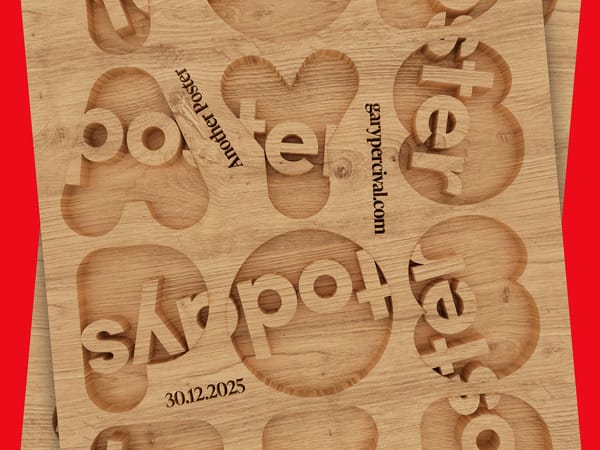Designers, Don't Give Up: Every Attempt Brings You Closer to Your Breakthrough
Rejection. That dreaded word that every creative and designer will encounter again and again in their career.


Rejection. That dreaded word that every creative and designer will encounter again and again in their career.
Whether it's a client saying "no" to your proposal or concept or an application for a dream project getting passed over, rejection stings. As freelancers, we take things personally, and it's easy to feel like a failure after a string of rejections.
I've been there too, doubting my skills after the latest "thanks, but no thanks" email from a client. The inner voice creeps in: Maybe I'm just not cut out for this. Maybe I should just give up on my dreams of being a successful creative.
But here's the truth—rejection and failure are all part of the process on the path to success. Every single accomplished designer has faced their share of no's and flops. And here's the key: each failure brings with it lessons and insights that you would never have gained otherwise.
Each attempt, even the unsuccessful ones, contains the kernels of wisdom that will lead to your eventual breakthrough if you persist.
So while rejection stings in the moment, shift your mindset to see it as providing data to inform your work and process. Mine each experience for whatever you can take away from it. And remember, the math is ultimately on your side—keep playing the numbers game, continue honing your craft, and your next attempt could just be the one that takes your career to new heights.
Reframe Failure as Iteration
It’s natural to see an unsuccessful attempt as a failure. But shifting your mindset to view these efforts as iterations rather than flops can work wonders.
While Thomas Edison is often credited with the invention of the lightbulb, it's more accurate to say he made significant improvements to existing designs to create a commercially viable version. The process involved extensive experimentation with different materials to find a durable and efficient filament. One of the materials that proved successful was carbonised bamboo.
"I have not failed. I've just found 10,000 ways that won't work," often attributed to Edison, encapsulates the spirit of persistence and iterative experimentation. It underscores the idea that each unsuccessful attempt was not a failure but a step closer to the solution.
By viewing each setback as a learning opportunity, Edison and his team were able to refine their approach and ultimately develop a lightbulb that was ready for mass production and commercial use.
Apply this iterative mindset to your creative process. Don’t seek immediate perfection. Be willing to try new things and see what works. Not every piece will be a home run, but each one represents a chance to improve.
Mine past rejections for any insights they provide. What didn't clients like about the work? What could be improved? Slowly incorporate these learnings into your future attempts. Build a portfolio over time that showcases your evolution.
Reframing unsuccessful efforts as productive iterations, not failures, keeps you in a growth mindset. You become less afraid of rejection and more open to the trial and error necessary to hone your craft. Persist in this process of small improvements, and over time, major breakthroughs follow.
Expand Your Network
As a freelance creative, you are the sole driver of your career.
That can feel isolating at times when you're facing rejection and self-doubt. One way to combat this is to actively expand your network.
Connecting with supportive peers and potential collaborators has multiple benefits:
- You realise you're not alone in your struggles. Others are grinding through similar challenges, which can give you motivation to keep going.
- Getting energised by peers' wins keeps you in a positive state of mind to persevere.
- Meeting more people expands your awareness of new opportunities and projects.
- Having a sounding board to get candid feedback on your work is invaluable.
- Successful mentors can provide guidance and battle-tested advice tailored to you.
- Your network is the conduit to future jobs; make nurturing it a habit, not just a need-only activity.
- Surrounding yourself with fellow creatives fosters inspiration to take your work to the next level.
Don't underestimate the power of community. We all need some solitude, but too much isolation can make the journey exponentially harder. Seek out conferences, online forums, meetups, portfolio reviews, and informational interviews.
Make it a goal to continually expand your circle; you never know which connection may lead to your next breakthrough.
Maintain Your Confidence
Rejection can batter your creative confidence if you let it. But maintaining self-belief throughout the ups and downs is key to persisting.
Believe in your potential for growth. View abilities as elastic rather than fixed. Your skills will continue to improve with dedicated practice over time. Don’t let current stumbles undermine your self-assurance.
Remember that rejection is common early on. Take inspiration from those a step ahead of you who also faced no’s before breaking through. Their path can be yours too with determination.
Stay motivated by focusing on the controllable—your work ethic and willingness to learn from errors. Regardless of external feedback, you have full control over your grit and mindset.
Be kind to yourself throughout the process. Creating outstanding work isn't easy for anyone starting out. Give yourself permission to fail while also holding yourself accountable to keep improving.
Surround yourself with a community of supportive peers who can empathise with the ups and downs of the creative journey. Getting energised by others’ success can help you persevere.
Finally, tune your inner voice to be encouraging rather than critical. Talk to yourself the way you would a close friend in a tough spot.
By keeping your confidence intact, you retain the motivation needed to power through repeated rejections on the road to success. Remember, even the greats faced failure on their way up. With belief in yourself and dedication to your craft, your skills will continue to grow.
The Math is On Your Side
While a series of setbacks might make you feel like the universe is conspiring against you, remember this: Over time, probability becomes your ally.
Every creative venture you embark upon is a fresh opportunity for success. Even if the outcome isn't always in your favour, the cumulative probability of achieving success grows with each attempt. In essence, persistence gradually tips the scales to your advantage.
Imagine you have a 10% chance of a client accepting your proposal. After 10 pitches, your odds of landing at least one client rise to 65%. Make 20 pitches, and your chances soar to 88%. It's not about chasing sporadic big wins; it's about the consistent effort that yields results.
In simpler terms, the more you put yourself out there, the higher your chances of hearing that coveted "yes." It's akin to the lottery: the more tickets you have, the better your odds. But there's a crucial difference: in your creative journey, you can actively refine your approach and enhance your odds.
Each attempt offers a chance to refine your work and discover what truly clicks. Continuous effort sharpens your skills. Feedback, even in the form of rejection, is invaluable. It helps you identify trends in what resonates and what falls flat. Every "no" is a lesson, another piece of the puzzle to perfect your approach.
While there's no guarantee of success for any single project, playing the long game significantly boosts your overall odds. Remember, every renowned creative faced their share of rejections before they hit their stride. They persevered, adapted, and waited for the right opportunity.
So, the next time a door closes, remind yourself that the odds are shifting in your favour. Stay tenacious, refine your craft, and know that your moment could be just on the horizon. Rejections are merely stepping stones, not setbacks, on your journey to success.
Learn from Rejection
When you get rejected, it's easy to simply feel discouraged and want to walk away. But every "no" contains valuable lessons if you take the time to reflect on what went wrong.
Here are some ways to mine rejections for insights to improve:
- If it's a client rejection, politely ask for candid feedback on why your proposal wasn't selected. Listen with an open mind to any critique.
- Look objectively at your work. What are some potential weak spots that could be turning off clients or collaborators?
- Study work that does get selected: what qualities make those projects appealing, and how can you integrate that into your work?
- Talk to peers who have succeeded recently; what strategies did they use to break through?
- Experiment with small tweaks to your creative process to see if they yield better results. Be scientific about it.
- Scroll back through old rejected work with fresh eyes; often the distance of time makes flaws more apparent.
- Research the portfolios and paths of creatives you admire; look for any common threads among their journeys.
The data is there if you resist the urge to either rationalise away the rejection or wallow in self-pity. Maintain your objectivity, put on your detective hat, and uncover every lesson possible. With time and continued effort, those lessons accumulate into the know-how that leads to success.
Keep an Inspiration File
When rejections pile up and your passion starts to lag, an inspiration file can reignite your creative fire. Collect a folder, binder, or Pinterest board filled with things that spark ideas and excitement.
Include:
- Work you admire from fellow designers and creatives. Study what makes it compelling.
- Quotes and sayings that resonate and uplift you.
- Challenging briefs and project ideas to get your juices flowing.
- Interesting materials, colour palettes, textures, typography, and compositions
- Imagery and scenes that capture a mood or concept you want to explore.
- Notes, lyrics, poetry fragments that get your mind racing.
- Sketches, false starts, wild ideas—don't be precious; capture anything that intrigues you.
Keep this inspiration file fresh and refer to it when you need a boost of energy. Let it guide you in new directions and unlock ideas. It provides a well to draw from when the rejection well runs dry.
Conclusion
The journey of a freelance creative is marked by challenges, especially rejections. Instead of seeing them as setbacks, view each "no" as a stepping stone towards your goal.
Remember, every accomplished creative faced their share of rejections before finding success. Probability is on your side; with each attempt, your chances of success increase.
Reframe failures as learning opportunities and stay motivated by your potential for growth. With determination and persistence, your breakthrough is closer than you think.
Stay the course, hone your craft, and maintain your confidence. Every rejection brings you closer to a "yes." Surround yourself with supporters and learn from every experience.
Your unique talent is invaluable, so keep pushing forward. The world awaits your vision, and your best work is still ahead. Keep going, and success will follow.



